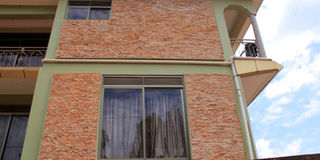Why you need to improve your house ventilation

An apartment showing an improved ventilation. Photo by Rachel Mabala
Like automobiles technology, house construction trends have also evolved over the years. For instance, doors and windows welded with louvres have replaced the traditional method of construction where home owners have abandoned ventilators that were normally positioned above the ring beam before roofing. This however comes with a number of health concerns.
Take for instance Julius Kawuki who always developed breathing complications at his home at Senge Village in Wakiso District. His house had louvres welded onto windows and doors to serve as ventilators. As if this was not enough, the curtain rails had also been positioned above the windows and doors, covering the roovers.
Survivors
“I always developed breathing complications especially in the bedroom and did not sleep well. I realised that it was a problem with ventilation when one of my sons visited home. He noticed that there was no proper air circulation in the house because the curtains blocked air flow through louvres,” Kawuki says.
Together with his son, Kawuki resolved to work out of the initial house architectural plan to replace the bedroom swing window with a sliding door and use a net mesh so that when one side of the door is slid, the other remains with a mesh to increase air circulation in the house.
Like Kawuki, Ambrose Agaba’s double self-contained rented house at Kisaasi was also constructed in a similar style with the would-be ventilators welded onto windows and doors.
While Kawuki was able to find a permanent solution to the poor aeration problem, Agaba’s hands are tied because he does not own the house to allow him make any adjustments like Kawuki.
“When I had just occupied the house, I always woke up in the middle of the night with congested nostrils and sweated a lot. I realised the bedroom was always hotter than the cool living room where I sometimes slept,” Agaba explains.
“I realised the curtains were blocking air flow in the bedroom. When I resumed sleeping in the bedroom, I decided to leave the door that separates the corridor and bedroom from the living room open at night. I only use a net curtain in the living room to let in fresh air because the house is raised that no one can see what is inside,” Agaba adds.
Misguided design
Isaac Kalema, an architect at Joy Projects along Bombo Road says welding louvres onto doors and windows to serve as ventilators is often done by home owners or landlords who want more ceiling height especially with apartment blocks or storeyed houses.
Traditionally, Kalema clarifies that normal doors without louvres are supposed to measure seven feet while windows are supposed to measure a height of four feet.
“What most home owners and landlords under the misguidance of welders do is increase the door height to eight feet to make the ceiling height long. Because of this appearance, you will forego using original ventilators because you do not want to go beyond the wall plate of three meters,” Kalema observes.
Dangers of poor ventilation
According to Umarashid Gulooba, a doctor at Makerere University Business School Clinic, when your house is poor ventilated, it may lead to airway diseases such as asthma, hyper reactive airway disease, rhinosinusitis and also worsen or expose you to chronic obstructive pulmonary disease.
Chronic obstructive pulmonary disease, he explains, is a lung condition that causes air obstruction in your lungs like Kawuki and Agaba, which may in the long run expose you to heart complications and lung cancer.
Symptoms include breathing complications characterised with a whistling sound from your chest. On the other hand, rhinosinusitis is also a condition when your mucus membranes undergo inflammation.
Budget differences
According to Kalema, you may forgo ventilators as fashion thinking it is the modern trend yet you are endangering the life of your family or tenants. You will also prefer having louvres over ventilators because you want the house to appear raised, all in the name of working within a tight budget.
Kalema clarifies and emphasizes that windows without welded louvres ought to be with a height of four feet instead of five feet when the window is welded with louvres. He advises that you cannot prefer welded louvres over ventilators because you want to save money yet ventilators are some of the cheapest building materials, with a piece costing between Shs500 to Shs1,500.
Architecturally, Kalema says a typical door without louvres costs approximately Shs400,000 yet one with louvres may cost approximately Shs500,000 or more depending on the thickness of the metal you choose to use.
“The difference of Shs100,000 or more is because the additional metal for louvres and the window or door height is in most cases expensive. This in the long run also increases the cost of the entire window and door that will push you out of the budget,” Kalema advises.
Apart from replacing the window like Kawuki, Kalema concludes that the other solution to poor air circulation in your house is to use the artificial air conditioner which is costly not only to buy but also to maintain.




